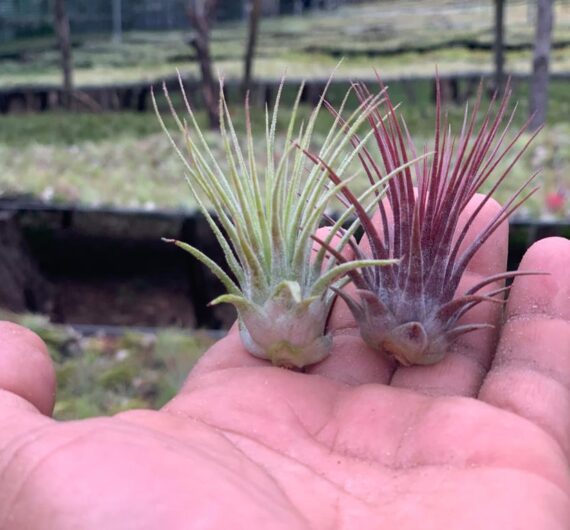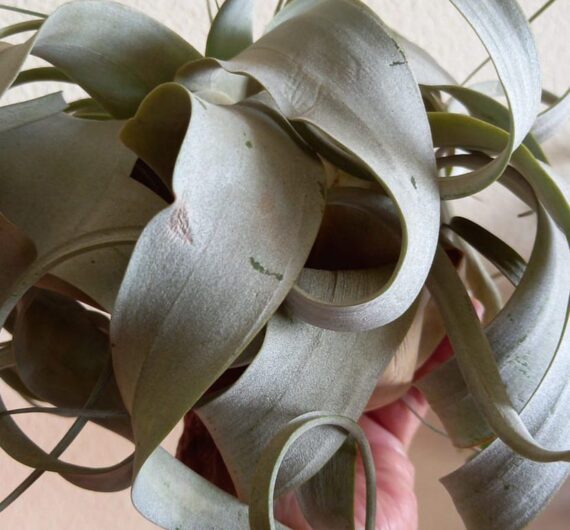
Tillandsia, commonly known as air plants, are beloved for their low-maintenance nature and ability to thrive without soil. However, like any plant, they can encounter problems if their needs aren’t met correctly. Browning tips, rot, and dehydration are among the most common issues air plant owners face. Don’t worry—most of these problems can be solved with a little attention and care. In this guide, we’ll walk you through the most common Tillandsia problems, how to troubleshoot them, and provide tips for keeping your air plants healthy and thriving.
Browning Tips
Dehydration or Too Much Sunlight
Browning tips are one of the most frequent issues Tillandsia owners encounter. This is often caused by dehydration, especially if the air in your home is dry, or if the plant isn’t getting enough water. Another possible cause is exposure to direct sunlight, which can scorch the leaves.
Solution:
Increase Watering: If your air plant’s tips are browning, it may not be getting enough moisture. Try increasing your watering schedule. Soak the plant in water for 20-30 minutes once a week, and mist it lightly in between soaks, especially if you live in a dry climate.
Adjust Lighting: Tillandsias need bright, indirect light to thrive. If your plant is in a spot where it receives harsh, direct sunlight, move it to a place where it gets filtered light, like near an east or west-facing window. If your plant is outside, provide shade to prevent burning.
Preventative Tips:
- Use filtered or rainwater to water your Tillandsia. Tap water with high mineral content can also lead to browning tips over time.
- Ensure your air plants dry completely after watering to avoid other issues like rot.
Rot

Overwatering or Poor Air Circulation
Rot is a more serious issue for Tillandsia, usually caused by overwatering or insufficient drying after watering. If water sits in the base or crevices of the plant for too long, it can lead to rot, which usually manifests as black or mushy spots on the leaves or base.
Solution:
Dry the Plant Thoroughly: After watering, make sure to shake off any excess water and place the plant upside down on a towel or a drying rack to allow all the water to drain out. This is especially important for species with thick, bulbous bases.
Cut Off Affected Areas: If rot is present, you can trim off the affected areas with sterilized scissors. Be sure to remove any mushy, black, or soft parts of the plant to prevent the rot from spreading. However, if the rot has reached the center of the plant, it may be too late to save it.
Increase Air Circulation: Rot is more likely to develop if the plant doesn’t have good air circulation. Keep your Tillandsia in a well-ventilated area, like near a fan or an open window, especially after watering.
Preventative Tips:
- Soak air plants for no more than 20-30 minutes and make sure they dry completely before putting them back in their display.
- Avoid placing air plants in enclosed terrariums with no airflow, as stagnant air can increase the risk of rot.
Dehydration

Infrequent Watering or Dry Air
Dehydration in Tillandsia can cause the plant’s leaves to curl or wrinkle. You may also notice the plant looking dull or shriveled. This is often a result of infrequent watering or being placed in an environment with low humidity.
Solution:
Increase Humidity: If you live in a particularly dry climate or have indoor heating, your air plants may need more moisture. In this case, mist them lightly every couple of days or place a humidifier nearby to raise humidity levels.
Soak More Frequently: In drier environments, soaking your Tillandsia twice a week may be necessary. If the plant’s leaves are extremely curled or wrinkled, a deep soak for an hour followed by proper drying can help revive the plant.
Preventative Tips:
- If your plant is dehydrated, consider placing it in a more humid area of the house, such as the bathroom or kitchen, where it can naturally absorb moisture from the air.
Fading Color or Dull Appearance
Lack of Light or Nutrients
Tillandsia leaves can start to fade or look dull if the plant isn’t receiving enough light or nutrients. These plants require bright, indirect light to maintain their vibrant colors, especially when they are in bloom. Additionally, like all plants, air plants benefit from some nutrients to stay healthy.
Solution:
Increase Light Exposure: Move your Tillandsia to a brighter location where it can receive more indirect sunlight. If your home doesn’t get much natural light, consider using a full-spectrum grow light for a few hours a day to provide the plant with the light it needs.
Feed Your Tillandsia: Air plants don’t need soil, but they do benefit from occasional fertilization. Use a bromeliad or Tillandsia-specific fertilizer once a month during the growing season. Be careful not to over-fertilize, as this can harm the plant.
Preventative Tips:
- Rotate your plant periodically to ensure it gets light evenly from all sides.
- Avoid placing your Tillandsia in dark corners or low-light areas.
Tillandsias are relatively easy to care for, but like all plants, they can suffer from common issues like browning tips, rot, and dehydration. By understanding the root causes of these problems and taking the proper steps to address them, you can help your air plants thrive for years to come. Remember, the key to healthy Tillandsia is the right balance of water, light, and air circulation, along with occasional checks for pests and overall health.
Have you faced any issues with your air plants? Share your experiences or any other tips you’ve found helpful in keeping your Tillandsia healthy in the comments below!